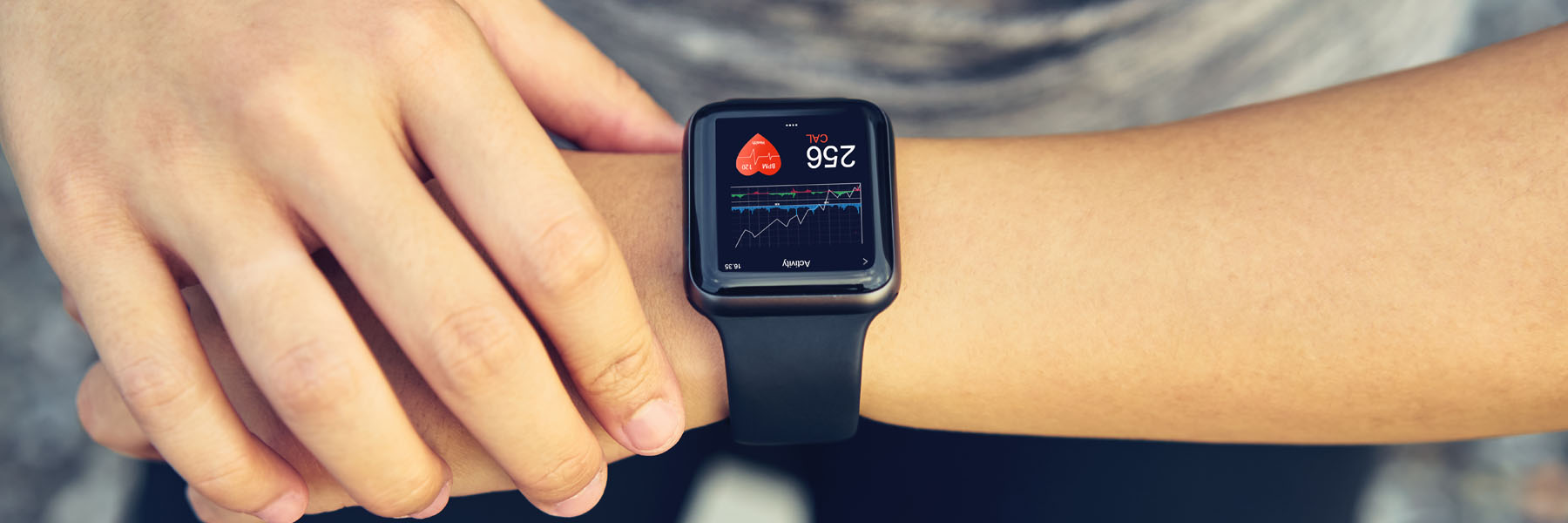Can Technology Protect Your Heart?

A cardiologist explains the advantages and limitations of wearable devices in predicting your heart health.
The digital landscape proliferates with wearable gadgets that promise to promote heart health. While some have merit, others have limitations, says Raul Mitrani, M.D., a cardiologist specializing in electrophysiology at the University of Miami Health System. “Nothing is 100%, but some devices can help me confirm a diagnosis of atrial fibrillation,” Dr. Mitrani says.
Atrial fibrillation (AFib or AF) is caused by an electrical disorder in the heart’s upper chambers. The symptoms include racing or irregular heartbeats and palpitations. AFib can cause significant symptoms and distress in some individuals while not causing symptoms in others. Some people who have AFib and rapid heart rates can develop a weakening of the heart muscle over time, which is called cardiomyopathy. The condition can also increase the risk of other heart-related problems and strokes. That’s why it’s essential to diagnose and treat recurring palpitations.
Ever-emerging technologies are intriguing, but in-home monitoring is nothing new. “We have used remote monitoring for over ten years in patients with pacemakers and defibrillators,” Dr. Mitrani says. He believes self-monitoring devices have their place, with caveats. Understanding the pros and cons helps protect your health and your pocketbook.
Can wearables predict a heart attack?
If you’re concerned about preventing a heart attack, don’t rush to buy a wearable. “I am not aware of any consumer device that can predict a heart attack,” says Dr. Mitrani. “A lot of patients have heart attack symptoms, go to the ER, get bloodwork and an EKG, stay in the hospital for 24 hours, and the doctors still don’t know if an attack occurred.” If that level of medical intervention can’t always prove a cardiac event, how can a smartwatch?
The bottom line? “If you’re having severe symptoms, go to the ER.”
An ally for finding AFib
For now, wearable devices cannot predict heart attacks, but they can help diagnose AFib. The condition is diagnosed with an electrocardiogram (EKG or ECG). An EKG or ECG measures electrical activity in the heart to see how well your heart functions. Although a small study proposed that ECG readings taken with a smartwatch might be sufficiently accurate, most health experts say that findings on a smartwatch that suggest AFib need to be confirmed by a specialist.
It’s not always easy to diagnose AFib since the symptoms can be elusive. “Some patients experience AFib, go to the ER, and the symptoms go away by the time they arrive. There’s a role for wearable devices in helping diagnose infrequent episodes. If a patient shows me an EKG from their home device, I can confirm the diagnosis.” Even though wearables may “over predict” AFib, Dr. Mitrani says they can be useful diagnostic tools when used in partnership with your doctor.
Which device should you use?
Choosing a device depends on several factors:
- Ease of use
- Accuracy
- Budget (Most devices are not covered by insurance. Some heart rate monitors do qualify for Health Savings Account or Flexible Savings Account expenditures.)
A few self-monitoring options include:
- Blood pressure monitors. Some monitors alert patients if they have an irregular pulse, though these machines can produce false positive and false negative readings. And they only detect potential arrhythmias when the patient uses the monitor.
- Smartwatches. Devices like Fitbit actively record pulse and heart rate and alert the wearer of irregularities. The Apple Watch analyzes heart rate irregularity, which can suggest AFib. The user can produce an EKG reading when they touch the watch knob with their opposite hand, which is important to confirm or not confirm an AFib diagnosis. A large study showed this device to be up to 84 percent predictive at diagnosing AFib. Dr. Mitrani says you are more likely to detect AFib if you wear your smartwatch all of the time.
- KardiaMobile. This single-lead device rests on your fingertip or chest to record heart rhythm and communicate an actual EKG reading to your Apple or Samsung smartphone. It does not monitor the heart continuously. This device is less expensive than an Apple watch and works with Samsung or iPhone devices.
Weighing the pros and cons
Though increasingly sophisticated, wearables still don’t compete with EKGs performed in a medical setting. “We use a 12-lead EKG that looks at the heart from 12 directions. Wearables have one lead that looks in one direction,” Dr. Mitrani says. EKG technicians also have the training and daily hands-on experience with performing EKGs. The most careful home user could be hampered by conditions out of their control, such as Parkinson’s disease, a previous stroke, or other impairments.
Do you need a wearable?
Although many performance athletes wear heart rate monitors while working out, otherwise healthy people with no AFib diagnosis or symptoms don’t need one. By age 80, Dr. Mitrani says that 10 to 25 percent of people may have had at least one episode of AFib. Even then, wearables aren’t always the answer. “In the elderly, ease of use plays a role. If technology makes them nervous, and they must be checked for AFib, we use medical grade implantable chips under the skin. The chip communicates with a monitor and sends me reports over the internet.” For some patients, that may be just the ticket to protecting their ticker. For others, digital devices are another way to become a more active participant in their heart health. For others, standard external recording devices worn anywhere from 24 hours to 30 days may be needed.
The good news is that there are multiple options to diagnose and confirm AFib. Your health professional can recommend the one that is right for you.
Nancy Moreland is a contributing writer for UMiami Health News. She has written for several major health care systems and the Centers for Disease Control and Prevention. You can also find her writings in the Chicago Tribune.
